
Novartis has spent billions of dollars restructuring its business over the last year, but is still looking for more deals, according to chief executive Joe Jimenez.
The dust has barely settled on the Swiss company’s latest transactions – the handover of its vaccines unit to GlaxoSmithKline in return for the latter’s oncology business and the sale of its animal health unit to Eli Lilly. Jimenez is however already in the market for mid-scale acquisitions in the $2bn-$5bn range to bolster its three core units in innovative pharma, eyecare and generics.
“We’re looking for assets that will help us strengthen the pipelines of each of our three businesses,” he said yesterday, adding Novartis intends to announce more deals within the next 12 to 18 months.
The company has already started adding to its assets in the hot cancer immunotherapy category, signing a $750m alliance with US biotech Aduro late last month and forming a dedicated immuno-oncology R&D unit at its Cambridge, Massachusetts campus.
Jimenez made the assertion on a conference call yesterday, in which Novartis reported a 7% reduction in first-quarter group sales to $11.94bn and operating profit that dipped slightly to $2.79bn, pegged back by unfavourable exchange rates.
The just-completed deals also include the creation of a consumer health joint venture with GSK and all told equate to a restructuring programme well in excess of $25bn, and have driven Novartis’ net debt up to a little under $18bn from just over $11bn a year ago.
Pharma back on growth track?
Novartis’ pharma division saw revenues fall 9% to $7.14bn in the quarter, but the company expects the second half of the year to pick up as it starts to reap the benefit of adding GSK’s cancer drugs, the launch of first-in-class psoriasis therapy Cosentyx (secukinumab) and towards the end of the year new heart failure therapy LCZ696 (valsartan/ sacubitril).
The company is now starting to recover from patent expirations on former top brands such as Diovan (valsartan) for high blood pressure and combination follow-up Exforge (valsartan and amlodipine), with new products now accounting for 41% of its turnover.
Among its fastest-growing products are oral multiple sclerosis therapy Gilenya (fingolimod), which climbed 26% to $638m in the first quarter, Tasigna (nilotinib) for chronic myeloid leukaemia brought in $372m, a rise of 20%, and myelofibrosis and polycythemia vera therapy Jakavi (ruxolitinib) which was up 86% to $90m.
Novartis’ push into chronic obstructive pulmonary disease (COPD) also reaped dividends with a trio of new respiratory drugs up two thirds to $132m.
Early access for LCZ696
The Swiss drug major is celebrating another positive development for LCZ696 after it became the first non-cancer drug to be awarded Promising Innovative Medicine (PIM) status in the UK.
PIM is the first stage in the UK’s Early Access to Medicines Scheme (EAMS), which aims to provide a way for patients with serious diseases to get access to new therapies before a European license has been granted. Novartis also has PIM status for its lung cancer candidate Zykadia (ceritinib).
LCZ696 has been tipped as a possible $5bn-a-year product and could be approved in the US in the third-quarter of this year and is also under regulatory review in Europe, Canada and Switzerland.




